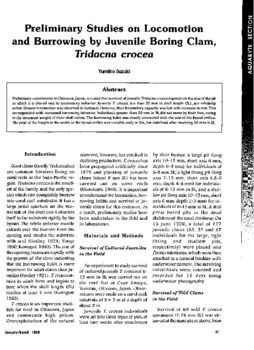Scientific Publication
Preliminary studies of locomotion and burrowing by juvenile boring clam, Tridacna crocea
Abstract
Preliminary experiments in Okinawa, Japan, revealed that survival of juvenile Tridacna crocea depends on the size ofthe pit in which it is placed and its locomotory behavior. Juvenile T. crocea, less than 20 mm in shell length (SL), are relatively active. Greater locomotion was observed in darkness. However, their locomotory capacity was lost with increase in size. This corresponded with increased burrowing behavior. Individuals greater than 20 mm in SL did not move by their foot, owing to the increased weight of the shell valves. The burrowing habit was closely connected with the size of the byssal orifice. The ratio of the length to the width of the byssal orifice was variable early in life, but stabilized after reaching 20 mm in SL

